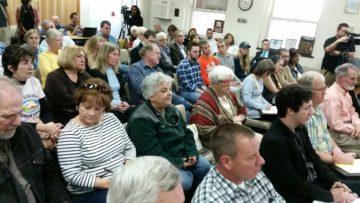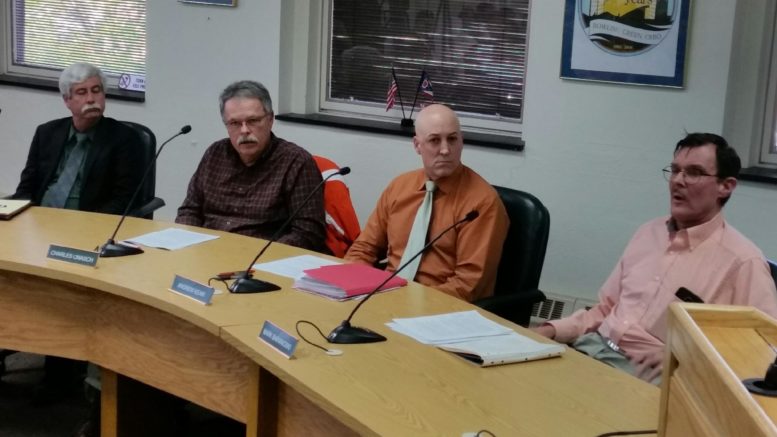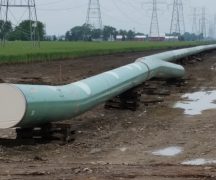By JAN LARSON McLAUGHLIN
BG Independent News
The probability of a local catastrophe with the proposed Nexus pipeline is quite low – but the magnitude of the damage it could cause is quite high. And Nexus engineering and geological data have failed to instill a lot of confidence with local officials.
A panel of geology experts answered questions Monday from Bowling Green officials concerned about the close proximity of the proposed 36-inch natural gas pipeline to the city’s water treatment plant and water intake on the Maumee River.
The geologists all agreed on one point – more study is needed before the pipeline is buried near a fault line and under the river.
The panel consisted of Dr. Charles Onasch, retired professor emeritus of geology at BGSU; Dr. Andrew Kear, assistant professor of political science and environment and sustainability at BGSU; Mark Baranoski, retired geologist with the Ohio Department of Natural Resources; and Stephen Champa, a senior hydrogeologist for Eagon & Associates. Steve Kendall, from WBGU and host of the Northwest Ohio Journal, acted as moderator.
Though the council chambers was full, the bulk of the questions were asked only by Kendall. The panel discussion was arranged by Mayor Dick Edwards after City Council kept hearing a wide variety of answers to basic questions about the pipeline risks. Edwards hoped the panel could focus on the science – not propaganda from pipeline protesters or the pipeline company.
But the geologists, to varying degrees, said more data is needed before science can give a stamp of approval to the pipeline.
Council President Mike Aspacher asked if the pipeline poses a real and credible threat to the city water treatment plant. Given the current information available, Champa said it does not. Onasch said it all depends on the engineering and construction. Kear said it does pose a threat, “in perpetuity.” And Baranoski said the “wild card” is the geology that needs more exploration.
Baranoski compared the panel to four guys using a stethoscope to figure out what’s underground. “We need a CAT scan. We need an MRI,” he said.
The big question mark in the plan is the Bowling Green Fault, which the pipeline will cross north of the city.
“It’s an ancient structure,” Onasch said. “It was very active.” But there’s no evidence of “recent” activity in the last 20,000 years, he said.
Champa agreed. “There’s been no movement since glacial times.”
But Baranoski said it’s a little more complicated than that, since the fault zone extends beyond the fault line itself. “It’s much more complex than the line on my map shows.”
And Kear voiced the most extreme concerns. “This is the worst possible place they can put this pipeline,” he said, defending the protesters as not simply “not in my backyard” types.
Onasch countered, saying that while “anything can happen,” the probability is quite low. “Yes, there are potential problems. We face danger in every step in our life.”
Kear said perhaps the bigger question isn’t how likely the risk is, but how catastrophic it could be if a problem occurred.
“What’s the magnitude or significance of the risk if it does happen,” Kear said.

Council chambers was filled for pipeline panel.
Baranoski said the pipeline company, in its reports, fails to define the word “risk.” “Risk to their pocketbooks, or risk to health and safety?”
Kear said the pipeline company’s information gathering and reporting have been lacking. “I wish Nexus would have had this panel,” he said.
Reports submitted on the pipeline plan don’t acknowledge the existence of the Bowling Green water plant, the fault, or the stone quarry located across the Maumee River. “None of this was brought to light,” Kear said. “We’re doing a lot of heavy lifting that Nexus should have done in the first place.”
Baranoski also said he was not satisfied with the information the pipeline company submitted on the Bowling Green Fault.
“If this report had come to me when I was working for the DNR,” he said, it would have been sent back with the list of all the unaddressed items.
Though additional information would be helpful, Champa said the village of Waterville recently put a waterline under the Maumee River to get water from the Bowling Green treatment plant.
“This kind of thing can be done safely in this area,” he said. Champa also said there was no potential for the river intakes to be compromised since they are 1,700 feet upstream from the proposed pipeline.
But Kear disagreed. “Just because it’s downstream doesn’t mean it’s not a risk.”
Both Onasch and Champa downplayed the potential for contamination to ground water, since the “impermeable glacial materials” don’t allow much movement, Onasch said.
The two also said there is little evidence in the area of karst, underground areas eroded by dissolution, producing ridges, towers, fissures and sinkholes. But Kear said the Federal Energy Regulatory Commission told pipeline officials to find out of karst exists in the area. “They have not made that publicly available. Why not?” Kear asked. “The potential is there.”
The recent incident of drilling fluid being dumped in Tuscarawas County by a different pipeline company was also discussed.
“We have very different geology here” with much greater glacial thickness, Champa said. However, the use of drilling fluid for the under-river crossing does concern Champa when it comes to possible residential wells close to the pipeline route.
Again, Kear voiced the most extreme concerns that the amount of drilling fluid used could create an earthquake measuring as much as 4.4 on the Richter scale. Though there have been no natural occurring earthquakes, “human triggered seismicity” could occur with the fluids in the fault zone.
Onasch said conditions could be created for seismic activity.
But Baranoski and Champa said it’s in the pipeline firm’s interest to limit lost fluids since that costs the company money.
The geologists voiced some displeasure and surprise that federal and state regulatory agencies weren’t asking for more information from the pipeline company. Many of the agencies don’t get involved until an incident occurs.
“We’d like to see a problem not happen,” Baranoski said.
Kear criticized FERC for giving “lip service” about the agency’s desire for public input. “But they don’t pay attention to it.”
“I’m not saying ‘Don’t put the pipeline in at all,’” Kear said. However, he repeated that the proposed route is the worst for the community. “We can engineer away some of the threat,” but it’s not worth the risks, he added.
So then the panelists were asked to identify other route options of the Nexus pipeline.
Champa said it could be moved upstream, but it would have to be at least one mile from the Bowling Green water plant.
“We wouldn’t be sitting here if it were five miles upstream,” Onasch said.
Kear said an alternative route was considered, but it added 40-some miles and considerable cost to the project. He suggested that city officials express their concerns to FERC. “Is FERC going to listen? I doubt it,” he added.
After all the questions were exhausted, the geologists agreed that more study is needed.
Baranoski stressed more information is needed about the Bowling Green Fault. “If this were my project, I’d certainly want to collect more.”
Edwards concurred. “Data shared with FERC is on the thin side.” He thanked the geologists for sharing their thoughts, which will help the city voice further concerns to FERC. “We’ve not been sitting idle,” the mayor said, listing off the politicians and agencies already contacted by the city about the pipeline.
As the panel discussion concluded, an audience member stood up and suggested that people unhappy with the pipeline route sign a petition for a Bowling Green charter amendment that would prohibit fossil fuel transportation infrastructure in the city or on city property. The petition is being circulated by a group called BG Climate Protectors. A total of 700 valid signatures are needed to get the issue on the November ballot.
Some in the audience were displeased that they were not able to ask their own questions of the panel. Edwards had asked that questions be submitted ahead of time to council members or city administration, so that the panel discussion would be organized and focused on the issue.




